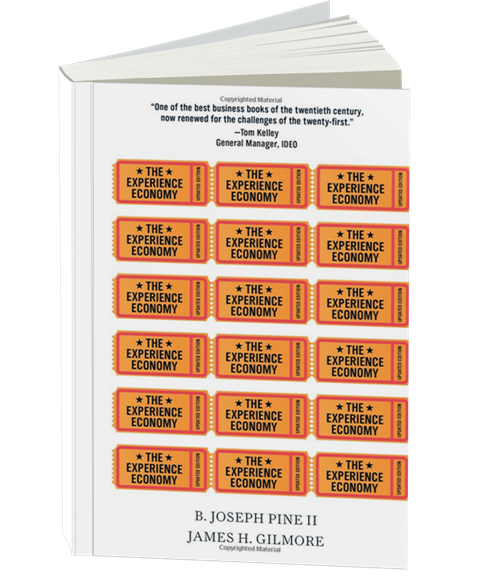The Experience Economy is described as an awesome resources for businesses. I’d propose that the book is a great read for educators as well. As you look back over your own high school and college years, I’m sure that you remember a lot more about experiences that you had in the classroom than you will ever remember about anything you memorized for a test. If you can remember how the teacher made you feel…or what something looked like or smelled like perhaps. I still remember my 7th grade English teacher singing a song to teach us the helping verbs. To this day…I remember all of the helping verbs and can still hear her voice singing the song. Our class had so much fun learning about grammar that day!
I highlighted several things while reading this book and look forward to finding ways to make sure that I incorporate meaningful experiences into the areas I have leadership over.
- Goods and services are no longer enough.
- Goods and services are no longer enough to foster economic growth, create new jobs, and maintain economic prosperity. To realize revenue growth and increased employment, the staging of experiences must be pursued as a distinct form of economic output. Indeed, in a world saturated with largely undifferentiated goods and services the greatest opportunity for value creation resides in staging experiences.
- Recognizing experiences as a distinct economic offering provides the key to future economic growth.
- Experiences have necessarily emerged to create new value.
- Those businesses that relegate themselves to the diminishing world of goods and services will be rendered irrelevant. To avoid this fate, you must learn to stage a rich, compelling experience.
- As with entertainment experiences, in educational experiences the guest (or student, if you prefer) absorbs the events unfolding before him. Unlike entertainment, however, education involves the active participation of the individual. To truly inform people and increase their knowledge or skills, educational vents must actively engage the mind (for intellectual education) or the body (for physical training). As Stan Davis and Jim Botkin write in The Monster Under the Bed, “The industrial approach to education…(made) teachers the actors and students the passive recipients. In contrast, the emerging new model (of business-led education) takes the market perspective by making students the active players. The active focus will shift from the provider to the user, from educators (teachers) to learners (students), and the educating act will reside increasingly in the active learner, rather than the teacher-manager. In the new learning marketplace, customers, employees, and students are all active learners or, even more accurately, interactive learners.
- “Competition for the retail dollar demands that we create a rich retail theatre that turns products into experiences.” -Henry Beer, CommArts design firm
- Edutainment=Education + Entertainment (holding attention)
Eduscapist=Education + Escapist (changing context)
Edusthetic=Education + Esthetic (fostering appreciation)
Escasthetic=Escapist + Esthetic (altering state)
Entersthetic=Entertainment + Esthetic (having presence)
Escatainment=Escapist + Entertainment (creating catharsis) - Experience orchestration has become as much a part of doing business as product and process design. The evidence is everywhere. In restaurants and retail stores, classrooms and parking garages, hotels and hospitals, leading companies set the stage for others now joining the Experience Economy. No longer in the embryonic phase of development, pioneering experience staging has resulted in practices that provide the starting point from which still further refinements will surely emerge.
- The sensory stimulants that accompany an experience should support and enhance its theme. The more effectively an experience engages the senses, the more memorable it will be.
- In the full-fledged Experience Economy, we will see no only portions of retail stores but entire shopping malls charge admission before a person is allowed to set foot in a store.
- Launching experiences worthy of charging admission is precisely what is needed in order to grow revenues, create jobs, increase wealth, and ensure continued economic prosperity now and in the future. Charging for goods and services is no longer enough.
- Individuals more and more want their offerings individualized to them.
- Customer satisfaction=What customer expects to get – What customer perceives he gets
Customer sacrifice=What customer wants exactly – What customer settles for
Customer surprise=What customer gets to perceive – What customer expects to get
Customer suspense=What customer does not yet know – What customer remembers from past - Merely completing an activity is not enough: some underlying motivation must invigorate the performance so that it ultimately affects the buyer of the final offering.
- In the end, a company’s people must take on responsibilities by each making choices to develop compelling representations that form a cohesive organization to engage guests in memorable ways.
- Human beings have always sought out new and exciting experiences to learn and grow, develop and improve, mend and reform.
- If you charge for stuff, then you are in the commodities business. If you charge for tangible things, then you are in the goods business. If you charge for the activities you execute, then you are in the services business. If you charge for the time customers spend with you, then you are in the experience business. If you charge for the demonstrated outcome the customer achieves, then and only then are you in the transformations business.
